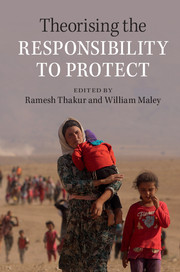Book contents
- Frontmatter
- Contents
- List of figures
- Notes on contributors
- Part I Context
- Part II The Responsibility to Protect, normative theory and global governance
- 5 The Responsibility to Protect and world order
- 6 International law and the Responsibility to Protect
- 7 The Responsibility to Protect, multilateralism and international legitimacy
- 8 Global governance and the Responsibility to Protect
- 9 International law, the Responsibility to Protect and international crises
- 10 The Responsibility to Protect and the just war tradition
- 11 War is not the answer: the Responsibility to Protect and military intervention
- Part III The Responsibility to Protect and international social purposes
- Index
9 - International law, the Responsibility to Protect and international crises
from Part II - The Responsibility to Protect, normative theory and global governance
Published online by Cambridge University Press: 05 August 2015
- Frontmatter
- Contents
- List of figures
- Notes on contributors
- Part I Context
- Part II The Responsibility to Protect, normative theory and global governance
- 5 The Responsibility to Protect and world order
- 6 International law and the Responsibility to Protect
- 7 The Responsibility to Protect, multilateralism and international legitimacy
- 8 Global governance and the Responsibility to Protect
- 9 International law, the Responsibility to Protect and international crises
- 10 The Responsibility to Protect and the just war tradition
- 11 War is not the answer: the Responsibility to Protect and military intervention
- Part III The Responsibility to Protect and international social purposes
- Index
Summary
As described in the genealogy provided in Chapter 2 of this volume by Gareth Evans, the notion and agenda of the Responsibility to Protect (R2P) emerged against the backdrop of the controversies over humanitarian crises and interventions in the 1990s. This amounted to less than a straightforward international legal obligation, but more than the simple appeal to moral decency that had prevailed previously, for instance in the context of the Convention for the Prevention and Punishment of the Crime of Genocide. Later, on the occasion of the 2005 United Nations (UN) World Summit, the international community, in agreeing to the wording of paragraphs 138–139 of the Outcome Document, went further by officially endorsing R2P as a legitimate norm and tool. As a result, in the following years it became rather normal to use the notion of R2P in the UN context, as illustrated by the various resolutions and statements of the UN Security Council referring to it, or, since 2009, by the annual reports of the UN secretary-general on the operationalization of R2P (reports followed by an informal dialogue in the General Assembly to discuss the secretary-general's findings and recommendations).
This evolution has not, however, settled the debates about R2P. Discussions continue on the circumstances and conditions in which this approach makes sense. This is especially the case concerning the use of force, by far the most controversial aspect of R2P and to which we particularly refer in this chapter. This situation is not surprising, especially considering the two types of challenges at the heart of the question of R2P. On the one hand, there is the structural challenge of R2P exacerbating the tensions and the dilemmas that can exist among the fundamental principles and values that national sovereignty, respect for human rights, national interest, solidarity and responsibility beyond borders constitute for the current systems of international relations and international law. On the other hand, there is the contextual and practical challenge of never being sure of what is the best course of action to address a humanitarian crisis, so that in the long run the situation gets better rather than worse.
This chapter analyses R2P, with special attention given to its use of force component, in relation to the structure of international law and some of the latest crises of the period. It is organised in three parts.
- Type
- Chapter
- Information
- Theorising the Responsibility to Protect , pp. 162 - 180Publisher: Cambridge University PressPrint publication year: 2015
- 3
- Cited by



